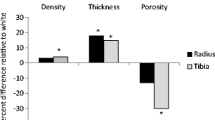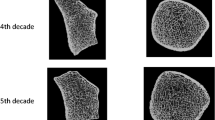Abstract
Men exhibit age-related adaptive changes in long bone geometry, namely, endosteal resorption and periosteal apposition of bone, that help to preserve bone strength. It is not clear whether women undergo similar adaptive responses. To address this question, we assessed the bone mineral density and cross-sectional geometry of the radius and ulna at the one-third distal site by single photon absorptiometry and computed tomography (CT) in healthy young (n=21, age 20–30 years) and older (n=22, age 63–84 years) women. We used the CT data to compute the total subperiosteal, medullary, and cortical areas, as well as the maximum, minimum, and polar moments of inertia. We normalized the geometric parameters for bone length and performed comparisons using both the original and size-corrected data. Radial and ulnar bone mineral content and density were 20–30% lower in the older women (P<0.0001). Ulnar width, total area, medullary area, and maximum and polar moment of inertia were greater in the older than in the younger women. Although we observed similar trends when we examined the radius data that were corrected for bone size, age-related differences in radial geometry were less pronounced and were not significant. We conclude that women undergo endosteal resorption and periosteal apposition of the ulna with age, thereby exhibiting an adaptive pattern that helps to preserve bone strength. The different behavior of these two bones suggests that local, rather than systemic, factors underlie this adaptation.
Similar content being viewed by others
References
Melton LJ III, Eddy DM, Johnston CC (1990) Screening for osteoporosis. Ann Int Med 112:516–528
Kanis J, Pitt F (1992) Epidemiology of osteoporosis. Bone 13:S7-S15
Owen RA, Melton LJ III, Johnson KA, Ilstrip DM, Riggs BL (1982) Incidence of Colles' fracture in a North American community. Am J Public Health 72:605–607
Riggs BL, Wahner HW, Dann WL, Mazess RB, Offord KP (1981) Differential changes in bone mineral density of the appendicular and axial skeleton with aging. J Clin Invest 67:328–335
Sowers M, Clark K, Wallace R, Jannausch M, Lemke J (1991) Prospective study of radial bone mineral density in a geographically defined population of postmenopausal Caucasian women. Calcif Tissue Int 48:232–239
Aloia JF, Vaswani A, Ellis K, Yuen K, Cohn SH (1985) A model for involutional bone loss. J Lab Clin Med 106:630–637
Davis JW, Ross PD, Wasnich RD, Maclean CJ, Vogel JM (1989) Comparison of cross-sectional and longitudinal measurements of age-related changes in bone mineral content. J Bone Miner Res 4:351–357
Hui SL, Wiske PS, Norton JA, Johnston CC (1982) A prospective study of change in bone mass with age in postmenopausal women. J Chron Dis 35:715–725
Riggs BL, Wahner HW, Melton LJ III, Richelson LS, Judd HL, Offord KP (1986) Rates of bone loss in the appendicular and axial skeletons of women. J Clin Invest 77:1487–1491
Ruegsegger P, Dambacher MA, Reugsegger E, Fischer JA, Anliker M (1984) Bone loss in premenopausal women. J Bone Jt Surg 66-A:1015–1023
Nilsson BE, Westlin NE (1974) The bone mineral content in the forearm of women with Colles' fracture. Acta Orthop Scand 45:836–844
Horowitz M, Wishart JM, Bochner M, Need AG, Chatterton BE, Nordin BEC (1988) Mineral density of bone in the forearm in premenopausal women with fractured wrists. Br Med J 297: 1314–1315
Eastell R, Wahner H, O'Fallon WM, Amadio PC, Melton LJ III, Riggs BL (1989) Unequal decrease in bone density of lumbar spine and ultradistal radius in Colles' and vertebral fracture syndromes. J Clin Invest 83:168–174
Eastell R, Riggs B, Wahner H, O'Fallon W, Amadio P, Melton L III (1989) Colles' fracture and bone density of the ultradistal radius. J Bone Miner Res 4:607–613
Härmä M, Karjalainen P (1986) Trabecular osteopenia in Colles' fracture. Acta Orthop Scand 57:38–40
Lester GE, Anderson JJB, Tylavsky FA, Sutton WR, Stinnet SS, DeMasi RA, Talmage RV (1990) Update on the use of distal radial bone density measurements in prediction of hip and Colles' fracture risk. J Orthop Res 8:220–226
Seeley D, Browner W, Nevitt M, Genant H, Scott J, Cummings S (1991) Which fractures are associated with low appendicular bone mass in elderly women? Ann Int Med 115:837–842
Wasnich RD, Ross PD, Heilbrun LK, Vogel JM (1987) Selection of the optimal skeletal site for fracture risk prediction. Clin Orthop Rel Res 216:262–269
Myers ER, Sebeny EA, Hecker AT, Corcoran TA, Hipp JA, Greenspan SL, Hayes WC (1991) Correlations between photon absorption properties and failure load of the distal radius in vitro. Calcif Tissue Int 49:292–297
Smith R, Walker R (1964) Femoral expansion in aging women: implications for osteoporosis and fractures. Science 145:156–157
Carlson DS, Armelagos GJ, van Gerven DP (1976) Patterns of age-related cortical bone loss (osteoporosis) within the femoral diaphysis. Hum Biol 48:295–314
Martin R, Atkinson P (1977) Age- and sex-related changes in the structure and strength of the human femoral shaft. J Biomechanics 10:223–231
Martin RB, Pickett JC, Zinaich S (1980) Studies of skeletal remodeling in aging men. Clin Orthop Res 149:268–282
Ruff C, Hayes W (1982) Subperiosteal expansion and cortical remodeling of the human femur and tibia with aging. Science 217:945–947
Ruff C, Hayes W (1988) Sex differences in age-related remodeling of the femur and tibia. J Orthop Res 6:886–896
Ruff CB, Hayes WC (1983) Cross-sectional geometry of Pecos Pueblo femora and tibiae—a biomechanical investigation: II. Sex, age, and side differences. Am J Phys Anthropol 60:383–400
Garn S, Rohmann C, Wagner B, Ascoli W (1967) Continuing bone growth throughout life: a general phenomenon. Am J Phys Anthropol 26:313–318
Meema H (1963) Cortical bone atrophy and osteoporosis as a manifestation of aging. Am J Roentgenol, Radium Ther, Nucl Med 89:1287–1295
Burr D, Martin R (1983) The effects of composition, structure and age on the torsional properties of the human radius. J Biomech 16:603–608
Garn S, Frosancho A, Sandusky S, McCann M (1972) Confirmation of the sex difference in continuing subperiosteal apposition. Am J Phys Anthropol 36:377–380
Ruff C, Hayes W (1983) Cross-sectional geometry of Pecos Pueblo femora and tibiae—a biomechanical investigation: I. Method and general patterns of variation. Am J Phys Anthropol 60:359–381
Katzman D, Bachrach L, Carter D, Marcus R (1991) Clinical and anthropometric correlates of bone mineral acquisition in healthy adolescent girls. J Clin Endocrinol Metab 73:1332–1339
Carter DR, Bouxsein ML, Marcus R (1992) New approaches for interpreting projected bone densitometry. J Bone Miner Res 7:137–145
Ruff CB, Trinkaus E, Walker A, Larsen CS (in press) Postcranial robusticity in Homo: I. Temporal trends and mechanical interpretation. Am J Phys Anthropol
Nagurka ML, Hayes WC (1980) An interactive graphics package for calculating cross-sectional properties of complex shapes. J Biomech 13:59–64
Ruff C (1984) Allometry between length and cross-sectional dimensions of the femur and tibia in Homo sapines. Am J Phys Anthropol 65:347–358
Sumner D, Olson C, Freeman P, Lobick J, Andriacchi T (1989) Computed tomographic measurement of cortical bone geometry. J Biomech 22:649–653
Horsman A, Leach A (1974) The estimation of the crosssectional area of the ulna and radius. Am J Phys Anthropol 40:173–186
Martin RB, Burr DB (1984) Non-invasive measurement of long bone cross-sectional moment of inertia by photon absorptiometry. J Biomech 17:195–201
van der Meulen MCH, Beaupré GS, Carter DR (in press) Mechanobiologic influences in long bone cross-sectional growth. Bone
Carter DR, Hayes WC (1977) The compressive behavior of bone as a two-phase porous structure. J Bone Jt Surg 59-A:954–962
Author information
Authors and Affiliations
Rights and permissions
About this article
Cite this article
Bouxsein, M.L., Myburgh, K.H., van der Meulen, M.C.H. et al. Age-related differences in cross-sectional geometry of the forearm bones in healthy women. Calcif Tissue Int 54, 113–118 (1994). https://doi.org/10.1007/BF00296061
Received:
Accepted:
Issue Date:
DOI: https://doi.org/10.1007/BF00296061




